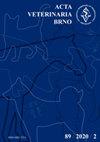商品和自体大肠杆菌疫苗组合对肉鸡种鸡生产性能、大体病理和大肠杆菌分离株多样性的影响
IF 0.7
4区 农林科学
Q3 VETERINARY SCIENCES
引用次数: 0
摘要
禽大肠杆菌病是全球家禽业经济损失的主要原因之一。在肉鸡养殖场,接种疫苗有助于预防产蛋期感染。针对禽致病性大肠杆菌(APEC)的有效疫苗接种可能是保护家禽的必要步骤,这取决于它们饲养的地区。本研究的目的是研究自体大肠杆菌疫苗对预先接种许可大肠杆菌疫苗(Poulvac®)的肉鸡饲养者的加性保护作用。本研究采用部分盲法和平行组设计。第1组24000只蛋鸡接种Poulvac®疫苗。第2组包括12 000只蛋鸡,接种了Poulvac®疫苗,另外在转移前肌肉注射了一种自体大肠杆菌疫苗。根据大体病理学、细菌学(大肠杆菌的分离和鉴定)和效用指标评估两组疫苗接种的有效性。病理结果显示,与1组相比,2组大肠杆菌多浆液炎综合征(EPS)、输卵管腹膜炎综合征(SPS)和出血性败血症的发生率降低。EPS (P < 0.001)和SPS (P = 0.0342)的发生率差异有统计学意义。组1和组2分离的大肠杆菌中血清型O78的比例也显著(P = 0.0178)。有效的多血清型疫苗接种方案,以扩大蛋鸡的异源保护,并将商业疫苗与自体疫苗相结合,是一种很有前途的预防管理工具。本文章由计算机程序翻译,如有差异,请以英文原文为准。
Impact of commercial and autogenous Escherichia coli vaccine combination on broiler breeder stock performance, gross pathology, and diversity of Escherichia coli isolates
Avian colibacillosis is one of the main causes of economic losses in the poultry industry worldwide. Vaccination could help to prevent infection during the laying period on broiler breeder farms. Effective vaccination against avian pathogenic Escherichia coli (APEC) may be an essential step for protection of poultry flocks depending on the region where they are raised. The aim of this study was to investigate the additive protective effect of an autogenous E. coli vaccine in broiler breeders pre-vaccinated with a licensed E. coli vaccine (Poulvac®). Our field study was partially blinded and parallel group designed. Group 1 included 24 000 laying hens vaccinated by Poulvac®. Group 2 comprised 12 000 laying hens vaccinated by Poulvac® and additionally, by an autogenous E. coli vaccine via intramuscular application before transfer. The effectiveness of vaccination in both groups was evaluated according to the results of gross pathology, bacteriology (isolation and characterization of E. coli) and utility indicators. Based on the pathology, the occurrence of E. coli polyserositis syndrome (EPS), salpingoperitonitis syndrom (SPS), and haemorrhagic septicaemia was decreased in Group 2 compared to Group 1. The difference in the occurrence of EPS (P < 0.001) and SPS (P = 0.0342) was significant. The proportion of serotype O78 among E. coli isolated from Group 1 and Group 2 was also significant (P = 0.0178). The effective and multi-serotype vaccination program in order to expand heterologous protection of laying hens and combination of commercial and autogenous vaccines seems to be a promising preventive management tool.
求助全文
通过发布文献求助,成功后即可免费获取论文全文。
去求助
来源期刊

Acta Veterinaria Brno
农林科学-兽医学
CiteScore
1.00
自引率
33.30%
发文量
36
审稿时长
18-36 weeks
期刊介绍:
ACTA VETERINARIA BRNO is a scientific journal of the University of Veterinary and Pharmaceutical Sciences in Brno, Czech Republic.
The scientific journal Acta Veterinaria Brno is dedicated to the publication of original research findings and clinical observations in veterinary and biomedical sciences. Original scientific research articles reporting new and substantial contribution to veterinary science and original methods that have not been submitted for publication elsewhere are considered for publication. A written statement to this effect should accompany the manuscript, along with approval for publication by the author´s head of department. The authors bear full responsibility for the contents of their contribution. Book reviews are published, too.
 求助内容:
求助内容: 应助结果提醒方式:
应助结果提醒方式:


